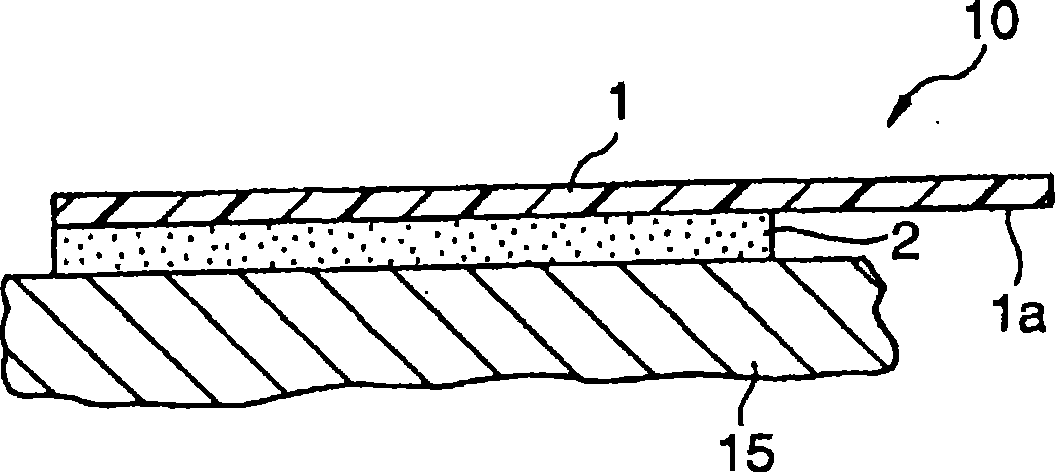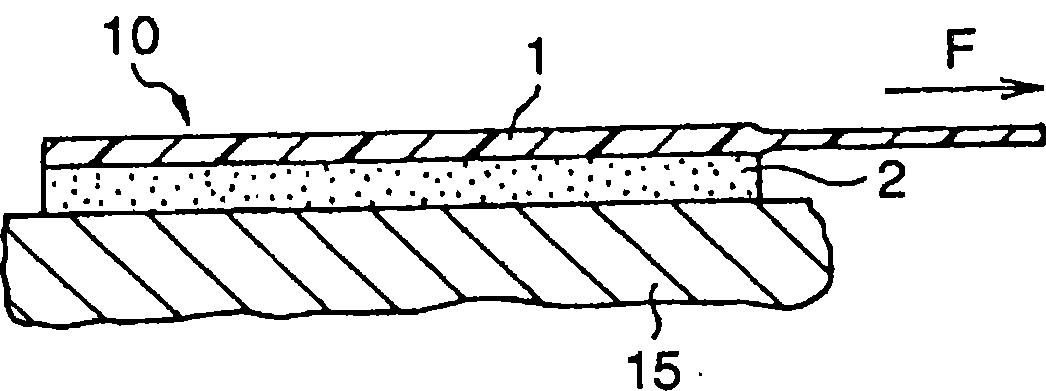Adhesive composition
A technology of adhesives and adhesive layers, applied in the direction of adhesives, adhesive types, ester copolymer adhesives, etc., can solve the problems of high adhesive strength and damage of the adherend, and achieve an excellent balance effect
- Summary
- Abstract
- Description
- Claims
- Application Information
AI Technical Summary
Problems solved by technology
Method used
Image
Examples
Embodiment
[0120] The present invention will be described below by referring to Examples, however, the present invention is by no means limited to these Examples.
[0121] The abbreviations used to illustrate the starting materials used in the following Preparation Examples are shown below.
[0122] EA: ethyl acrylate
[0123] BA: butyl acrylate
[0124] IOA: Isooctyl acrylate
[0125] DMAEA: Dimethylaminoethyl Acrylate
[0126] Vim: 1-vinylimidazole
[0127] AA: Acrylic
[0128] StyM: Styrene Macromonomer
[0129] A styrene macromonomer having the following properties and structural formula was prepared according to the method described in Japanese Unexamined Patent Application (Kokai) 59-75975, page 14, upper right column, monomer "C-3".
[0130] (nature)
[0131] 50 wt% solution of methacrylate-terminated polystyrene / cyclohexane
[0132] Weight average molecular weight = 13,000 (by GPC)
[0133] (structural formula)
[0134] CH 2 =C(CH 3 )C(=O)-O-CH 2 CH 2 -Polystyrene-C...
preparation Embodiment 1
[0163] Preparation of Acrylic Copolymer
[0164] As shown in Table 1 below, 81 parts of ethyl acrylate, 12 parts of butyl acrylate, 5 parts of 1-vinylimidazole, 2 parts of acrylic acid and 233.3 parts of ethyl acetate were added to a pressure glass bottle. Subsequently, 0.2 parts of 2,2'-azobis(2,4-dimethylvaleronitrile) was added as a polymerization initiator, and nitrogen gas was introduced for 10 minutes from an inert gas inlet tube fixed to the glass bottle, thereby using Nitrogen flushing system. Immediately after nitrogen flushing, the glass bottle was sealed with a cap, and polymerization was performed in a constant temperature water bath at 50° C. for 20 hours. The intrinsic viscosity of the acrylic copolymer was measured from the obtained acrylic copolymer solution and found to be 1.19 dl / g.
preparation Embodiment 2
[0166] Preparation of Acrylic Copolymer:
[0167] The procedure of Preparative Example 1 was repeated, but in this example, the starting materials were changed as indicated in Table 1. The intrinsic viscosity of the acrylic copolymer was measured from the obtained acrylic copolymer solution and found to be 1.42 dl / g.
PUM
| Property | Measurement | Unit |
|---|---|---|
| glass transition temperature | aaaaa | aaaaa |
| thickness | aaaaa | aaaaa |
| elongation at break | aaaaa | aaaaa |
Abstract
Description
Claims
Application Information
 Login to View More
Login to View More - R&D
- Intellectual Property
- Life Sciences
- Materials
- Tech Scout
- Unparalleled Data Quality
- Higher Quality Content
- 60% Fewer Hallucinations
Browse by: Latest US Patents, China's latest patents, Technical Efficacy Thesaurus, Application Domain, Technology Topic, Popular Technical Reports.
© 2025 PatSnap. All rights reserved.Legal|Privacy policy|Modern Slavery Act Transparency Statement|Sitemap|About US| Contact US: help@patsnap.com



